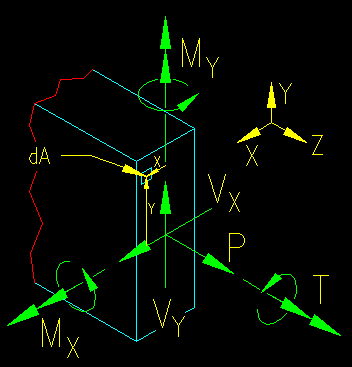|
|
Section 9.2
The Combined Effects of Axial and Bending Forces
Last Revised: 06/16/2023
|
Figure 9.2.1 |
 |
The three internal translational forces on a section, as seen in Figure 9.2.1, are axial, shear in the x and shear in the y directions. The three internal rotational forces are torque, bending about the x axis, and bending about the y axis.
The axial force, P, and bending moments about the x axis and y axis, Mx and My, each create normal stress on the cross-section. The other three forces (T, Vx, and Vy) create shear stress on the cross-section.
The magnitude of the internal forces changes as a function of location along the member. It is also most likely that the maximums for each internal force do not occur at the same location along the member. One challenge of the analysis process is to find the location in the member where the maximum total normal stress is found.
The total normal stress at any point (along the member and on the section - for example at dA in Figure 9.2.1), using superposition, is the sum of the normal stresses created by the axial and bending forces at that location on the member.
stotal = saxial + sbending-x + sbending-y
Using the appropriate equations from mechanics, the total stress at a point can be expressed as:
stotal = P/A + Mxy/Ix + Myx/Iy
Where:
- P, Mx, and My are simultaneously occurring internal forces at the same location on the member and
- x and y are the respective distances from the y and x axes.
Be careful to avoid the mistake of finding the maximum P, maximum Mx, and maximum My along the member then combining the effects from these three maximum forces. To do so creates a fictionally high total stress that does not occur anywhere in the member unless these peak values just happen to occur at the same location on the member. Finding the maximum value of stotal may require you to look at several locations along the member as it may not be readily apparent were this will occur when the maximum values of P, Mx and My do not occur simultaneously at the same location on the member.
The maximum compressive and/or tensile normal stresses will each occur at a point on the perimeter of a section when bending is present. This simplifies your search for the maximum occurring stress on a given cross-section.
In mechanics, you are taught that the maximum tensile stress and maximum compressive stress in a member must be kept within acceptable limits in order to be safe. These limits on bending and axial stress are not always the same for each type of stress.
A typical limit state equation takes the form:
saxial <
saxial,allowable
sbending-x
< sbending-x,allowable
sbending-y < sbending-y,allowable
Where the allowable values may all have different magnitudes. A problem arises when trying to determine the value to use stotal,allowable. Ideally we would like to find an equation similar to:
stotal = saxial + sbending-x + sbending-y < stotal,allowable
It makes sense that stotal,allowable should be a weighted average of the individual allowable stresses. To attempt this, the limit state equations can first be rewritten as:
saxial /
saxial,allowable < 1.00
sbending-x /
sbending-x,allowable < 1.00
sbending-y / sbending-y,allowable
< 1.00
In each of these equations the capacity ratio is compared against the same value: 1.0.
By adding the above limit state equations together and setting the sum to be less than 1.0 results in an equation (known as an interaction equation) that essentially is a weighted average of the three allowable individual stress components. The resulting general form of the equation is:
![]()
This method avoids the need to explicitly define a weighted composite sallowable by limiting the sum of the ratios to be less than 1.0. This is the general approach taken in the SCM and by other structural material design specifications.
The difference between stress and force is generally a section property such as Area or Section Modulus. Consequently, multiplying each stress by its appropriate section property, the interaction formula based on strengths is:
![]()
Where the terms with the subscript "r" are the internal forces (i.e., required strength) and the terms with the subscript "c" are the member capacities or member strengths.
The last equation above is the GENERAL FORM of the SCM combined bending and axial force interaction formula.
<<< Previous Section <<< >>> Next Section >>>